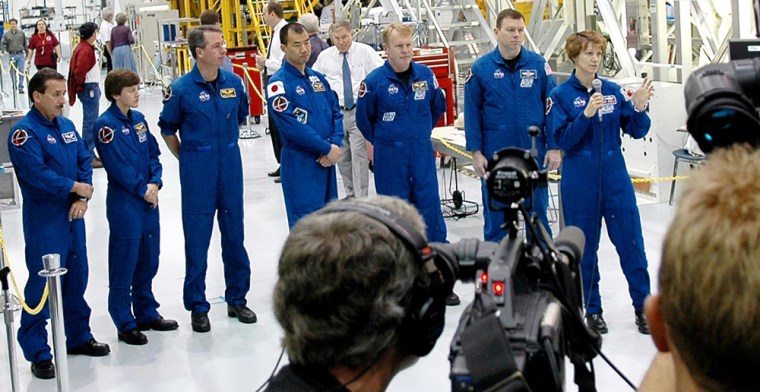With just three months remaining until liftoff, the astronauts assigned to the first space shuttle flight since the Columbia catastrophe still don’t know what type of repair kit will accompany them into orbit.
It’s late in the game and shuttle managers need to decide soon, the mission’s commander, Eileen Collins, said Thursday.
The problem is, none of the five options for patching gashes in the hull of an orbiting shuttle is all that good. Nonetheless, Collins said she and her crew will have at least one type of repair method on board when Discovery takes off on the first shuttle flight in more than two years, as early as mid-May.
“We only can do so much. We can’t test everything. We have to decide what we are going to test,” Collins, NASA’s first female shuttle pilot, told reporters during a break in training at Kennedy Space Center.
No option works completely
None of the five options under consideration could repair a hole the size of the one that destroyed Columbia on Feb. 1, 2003. The hole in Columbia’s left wing was an estimated 6 to 10 inches across (15 to 25 centimeters across), and was caused by a piece of foam insulation that broke off the external fuel tank at liftoff.
Because the seven shuttle astronauts have been training for so long, they have some flexibility for taking on last-minute tasks, said Collins, 48, a retired Air Force colonel. “I think we’re going to get a decision here very soon on what we’re going to be doing,” she said, standing next to the cargo carrier that will be mounted into Discovery.
Developing a method for patching cracks and holes in the shuttle’s hull has proven to be one of the most difficult challenges confronting NASA since Columbia shattered during re-entry over Texas, killing all seven aboard. The goal for the first flight is to have something to demonstrate for future use, and to use in case Discovery is damaged.
Test flight
Discovery’s trip to the international space station, to deliver badly needed supplies and replacement parts, is considered a test flight because of the brand new fuel tank, redesigned to keep dangerous chunks of foam from coming off.
The shuttle is equipped with new sensors in the wings to detect impacts, and a bevy of cameras will photograph the entire launch. Once in orbit, the astronauts will use a new 50-foot (15-meter) attachment to the shuttle robot arm to inspect Discovery’s exterior.
“It’s a very, very detailed analysis that the vehicle will be subject to, which it’s never had before,” said astronaut Andrew Thomas. “On that basis, I’m very confident that if there were any damage, we’d certainly be aware of it in the unlikely event that it happens — and I think it is unlikely.”
As she has before, Collins stressed she would not fly on something she felt was unsafe.
“I’m a person who won’t even get on a roller coaster at an amusement park because they scare me. I’ve been on one once and I won’t do it again,” she said. “But I believe in what we’re doing.”
“There is risk in spaceflight,” she said. “But, yes, I certainly feel it’s going to be safe.”
